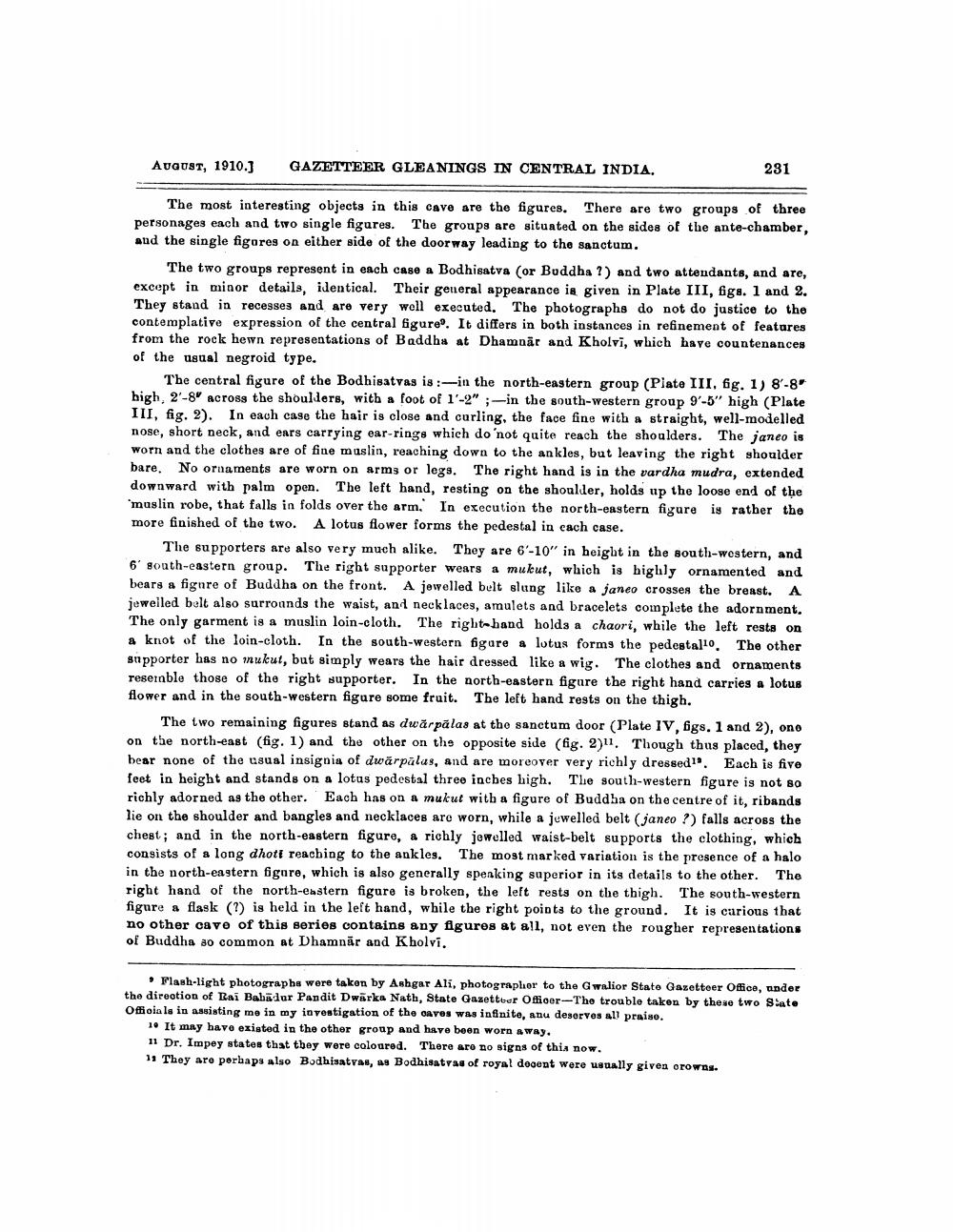________________
August, 1910.)
GAZETTEER GLEANINGS IN CENTRAL INDIA.
231
The most interesting objects in this cave are the figures. There are two groups of three personages each and two single figures. The groups are situated on the sides of the ante-chamber, and the single figores on either side of the doorway leading to the sanctum.
The two groups represent in each case a Bodhisatva (or Buddha ?) and two attendants, and are, except in minor details, identical. Their general appearance is given in Plate III, figs. 1 and 2. They stand in recesses and are very well executed. The photographs do not do justice to the contemplative expression of the central figure. It differs in both instances in refinement of features from the rock hewn representations of Baddha at Dhamnär and Kholvi, which have countenances of the usual negroid type.
The central figure of the Bodhisatvas is :-in the north-eastern group (Plate III, fig. 1) 8-8" high, 2-8" across the shoulders, with a foot of 1-9" ;-in the south-western group 9'-5" high (Plate III, fig. 2). In each case the hair is close and curling, the face fine with a straight, well-modelled nose, short neck, and ears carrying ear-rings which do'not quite reach the shoulders. The janeo is worn and the clothes are of fine maslin, reaching down to the ankles, but leaving the right shoulder bare. No ornaments are worn on arms or legs. The right hand is in the vardha mudra, extended downward with palm open. The left hand, resting on the shoulder, holds up the loose end of the 'muslin robe, that falls in folds over the arm. In execution the north-eastern figure is rather the more finished of the two. A lotus flower forms the pedestal in each case.
The supporters are also very much alike. They are 6-10" in height in the south-western, and 6' south-eastern group. The right supporter wears a mulut, which is highly ornamented and bears a figure of Buddha on the front. A jewelled belt slung like a janeo crosses the breast. A jewelled belt also surrounds the waist, and necklaces, amulets and bracelets complete the adornment. The only garment is a muslin loin-cloth. The right-hand holds a chaori, while the left resta on a knot of the loin-cloth. In the south-western figare a lotus forms the pedestalo. The other supporter has no mukut, but simply wears the hair dressed like a wig. The clothes and ornaments reserable those of the right supporter. In the north-eastern figure the right hand carries a lotus flower and in the south-western figure some fruit. The left hand rests on the thigh.
The two remaining figures stand as dwarpālas at the sanctum door (Plate IV, figs. 1 and 2), ono on the north-east (fig. 1) and the other on the opposite side (fig. 2). Though thus placed, they bear none of the usual insignia of dwärpālas, and are moreover very richly dressed". Each is five feet in height and stands on a lotus pedestal three incbes high. The south-western figure is not so richly adorned as the other. Each has on a mukut with a figure of Buddha on the centre of it, ribands lie on the shoulder and bangles and necklaces are worn, while a jewelled belt (janeo ?) falls across the chest; and in the north-eastern figure, a richly jewelled waist-belt supports the clothing, which consists of a long dhoti reaching to the ankles. The most marked variation is the presence of a halo in the north-eastern figure, which is also generally speaking superior in its details to the other. The right hand of the north-eastern figure is broken, the left rests on the thigh. The south-western figure a flask (?) is held in the left hand, while the right points to the ground. It is carious that no other cave of this series contains any figures at all, not even the rougher representations of Buddha ao common at Dhamnär and Kholvi.
Flash-light photographs were taken by Ashgar Ali, photographor to the Gwalior Stato Gazetteer Ofice, andor the direotion of Rai Babador Pandit Dwarka Nath, State Gazetter Officer-The trouble taken by these two Sato Officials in assisting me in my investigation of the OAVOS was infinite, anu deserves all praise.
1. It may bavo existed in the other group and have been worn away. 11 Dr. Impey states that tbey were coloured. There are no signs of this now. 15 They are perhaps also Bodhisatvas, as Bodhisatvas of royal docent were usually given orowas.




